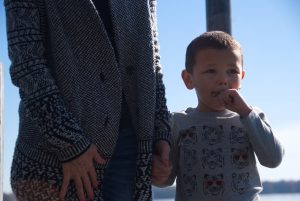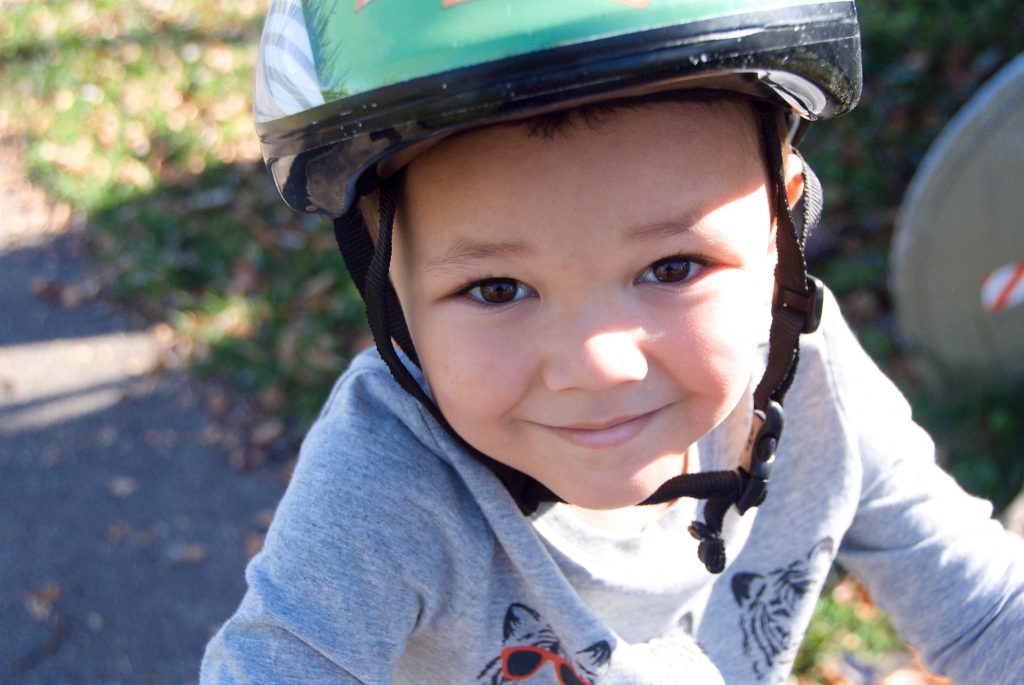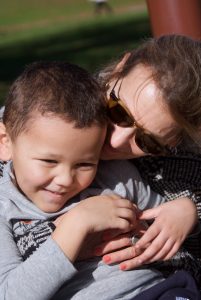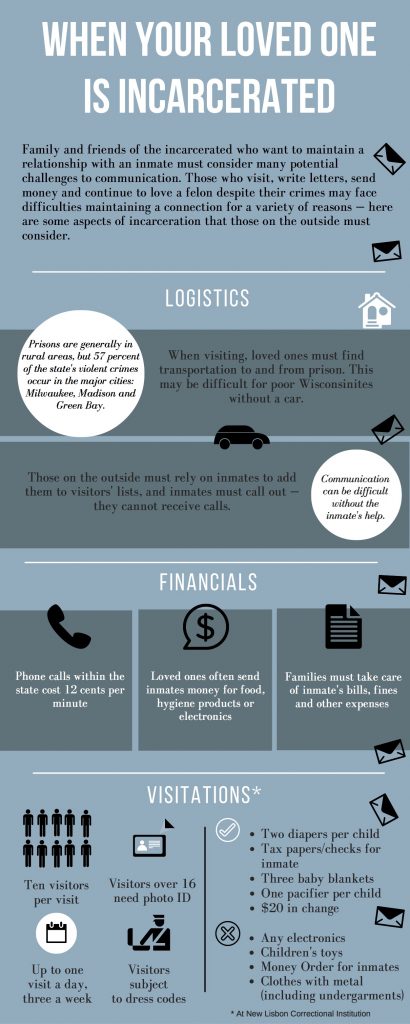When Damien was three months old, he, his mommy and his daddy lived in a little house on the east side of Madison. At the time, his mother, Nina, 22, worked as a certified nursing assistant, and his father, Smoody (Damien Smith), 23, had just been released from prison. Damien is now 4 years old, and he doesn’t remember living with his parents in the cute house the size of an apartment. But in that little house, Damien was surrounded by those who loved him.
Last year, 22,544 inmates were incarcerated in one of the 23 state institutions in Wisconsin. Smoody, Damien’s dad, was one of them, and he will remain there until 2026 unless he is granted parole. In terms of overall incarceration, Wisconsin falls somewhere in the middle compared to the rest of the country — the state incarcerates about 371 people per 100,000. According to Tristan Cook, communications director at the Wisconsin Department of Corrections, the state provides services such as extended visiting in some cases and family day events for minimum-security inmates.
For most families, prison seems distant and removed from ordinary life, a place where offenders are contained far away from law-abiding citizens. But reality is more complex: the burden of incarceration is being shouldered disproportionately by Black Wisconsinites, where prison isn’t a nightmare unheard of in their community, but something that spills into the lives, minds and hearts of many living outside the boundaries of the armed guard towers.
It takes a bird’s-eye view to see that Wisconsin incarcerates Black men at a higher rate than anywhere else in the country: one in eight. Although just 6.6 percent of Wisconsin is Black, 40.1 percent of the prison population is African American. This is the mass incarceration of Black men that we hear of occasionally in studies or news articles: figures and data without names and faces, but an important measure of disparities nonetheless. But zoom in closer — to a parent, a friend, a child of the incarcerated — and a different picture emerges.
A person’s imprisonment works both ways — inmates are locked in, and loved ones are locked out. Especially vulnerable are children of the incarcerated, who become entangled in the complex criminal justice system on top of growing up without one or both parents at home. They feel this reality in Wisconsin not by numbers and reports but in waiting for letters to be returned, for the phone to ring and to hear the recording telling them an inmate is trying to reach them — they count incarceration by the birthdays, bike falls and first dates that will be missed by someone they love.
The act of loving someone despite their crimes is an act of hope. Those on the outside will continue to write, continue to travel, continue to call despite the shame associated with being incarcerated. They see something many of us can not.
Pat Dillon, a Madison-based writer, artist, teacher and advocate, recalls the day she got the news that would change her life — and herself — completely.
“When I found out Smoody was sentenced to 13 years in prison… it felt like a death. It felt like a death of a really small child,” Dillon says. Dillon’s daughter, Nina, and Smoody are parents to Dillon’s grandson, Damien. In 2013, Smoody was sentenced to 13 years for distribution of crack cocaine and heroin, adding to his criminal record and prior convictions that landed him in prison.

Many of Smoody’s crimes began with what are referred to as crimes of poverty. Children being forced to steal food to survive is not uncommon; as a young boy, Smoody stole new school clothes that he needed. Despite being exposed to violence, substance abuse and crime at a young age, Dillon describes Smoody as intelligent and motivated — in high school, he earned straight A’s. After he was expelled as a senior for allegedly having a gun — which was never found — he returned to complete his education through a special program. To Dillon, Smoody’s sentence was a bright, beautiful life snuffed out.
Although Dillon knows the reality of Black incarceration, she does not absolve Smoody from the crimes for which he is now serving time. Smoody was the first person in Nina’s close circle of relationships who was entrenched in the criminal justice system. When Nina moved in with Smoody, who had become a drug dealer, relationships with Dillon’s extended family were pushed to the brink. Dillon, who is White, struggled to find support from friends and family who had never experienced the reality of mass incarceration, especially in Black communities.
“I was beside myself with grief even though this is a young man who really put a lot of strain on my life,” Dillon recalls. “I always felt like he had kidnapped my daughter. He did a lot of bad stuff.”
Dillon and her daughter both seek to bring awareness to mass incarceration rather than pushing it further into the corners of discussion and shame. “I’m not embarrassed to tell people my son’s dad is in prison,” Nina says. “The issue needs attention — it’s important to bring awareness.”

Since Smoody has been incarcerated, Dillon has taken on much of the responsibility of raising his young son with her daughter. Dillon estimates that she cares for Damien at least half of the time in addition to keeping in close contact with his dad — she talks to Smoody on the phone about twice a week, and between Nina and Dillon, Damien goes to visit his dad at the prison in central Wisconsin, at least once a month.
Dillon and Damien drive an hour-and-a-half to the New Lisbon Correctional Institution to visit Smoody. They bring $20 — the maximum amount of money visitors are allowed to carry in — to buy Smoody microwave food from the vending machines. Damien cannot bring in toys or books, and Dillon cannot bring in a purse or a cell phone. They sit at cafeteria-style tables, waiting with other family and friends for their loved ones. The visitation room is bleak, not a place to nurture a relationship already divided by distance, fences, guards and bars.
When Smoody is brought into the visitation room, Damien forgets the rule of no running on Department of Corrections property and flies into his father’s arms. Dillon describes it as though it is like watching Smoody walk through the front door after work, greeted by his little boy waiting for him. Damien sits on Smoody’s lap throughout the entire visit, soaking up every minute spent with his dad. Later he will ask Dillon how old he’ll be when his father is out of prison — maybe 13 — but at least right now, there is no judgment, no embarrassment, no stigma. Smoody might as well be walking through the front door; to Damien, his dad has always been a good father.
“I don’t place judgement on people as much now,” Nina says. “People in prison are still people. Smoody is still Damien’s dad — he has people who love him.”
Since Smoody’s incarceration, Dillon says their relationship went from one of strain and secrecy to one that blossomed with trust — something the common narrative of incarceration doesn’t often contain. Their relationship is loving and trusting, and Dillon has worked tirelessly to guarantee that when Smoody gets out, he has the support that will make or break his successful reentry into society.
“He opened his heart to me,” Dillon says. “I’ve always had my heart open to him, but now he’s opened his heart. My actions have proven to him that all I want is for him to have an opportunity… and [I’ve shown him] that when he gets out, he doesn’t have to be afraid of the world.”
“One of the main false hopes is that you’ve done your time,” says Anthony Cooper. He has been out of prison for more than 15 years but still remembers struggling to find employment, housing and other essentials after he was released. He recalls the pain of seeing his sons cry when visitation was over, begging to stay with him in prison, and he vowed to never let them see their father in that situation again. But with a felony on his record that followed him everywhere he went, employment options were slim, and Cooper was turned away from countless jobs despite being qualified — it wasn’t until then that he finally understood the bigger picture of mass incarceration.
Few understand the struggle of reentry better than Aaron Hicks. Hicks, now 43, has been “on paper” — on probation or parole — since he was 12. His record follows him like an invisible shadow, and his ankle monitor, which he will likely wear for the rest of his life, serves as a tangible reminder of how he continues to serve time despite being released from his cell. “It’s never really over,” Hicks says. “You’ve never really paid your dues to society.”
Cooper, who is now the director of reentry services at the Nehemiah Center for Urban Leadership Development, and Hicks, assistant to reentry services, organize and lead Man Up, a support group for those recently released, preparing to be released or struggling to get their footing in society after being away. Both emphasize the powerful effects mass incarceration has on Black communities. Hicks says Black Americans feel the weight of the criminal justice system more heavily than other groups.
“The truth is, specifically for a Black man, you can get pulled over and that could be the last time we take another breath,” Hicks says. “You see it initially, prior to mass incarceration in slavery — how Black people have had to fight for everything.”
Cooper and Hicks say providing support following an inmate’s release is essential for a successful transition, but they find themselves frustrated by the lack of resources provided by the criminal justice system for reentry.
“[The government spends] the least money on people re-entering into the community — that in itself should speak volumes,” Hicks says. “The truth is, 85 to 90 percent of people who go into prison will get back out. If that’s the case, then why wouldn’t we spend more money on services that would help individuals enter back into the community and be productive?”
He answers his own question.
“This is a business. This is by design,” Hicks says. “Never think for any reason that [mass incarceration] is one big mistake. This was strategic — everything about this system.”
Smoody and Damien are four years into a 13-year sentence. Damien came to the understanding that his father is in prison on his own and recognizes that a visit to New Lisbon is the only opportunity to see him. Once, when he found out his mom had visited Smoody without him, he couldn’t believe it — “What? She didn’t take me?” he asked, shocked and upset.

A while ago, Nina drove Damien past the little house on the east side. She told him about the little house, how they all had lived there together: Nina, baby Damien and even his dad. Damien can’t seem to let go of the fact that he used to live in a little house with his mom and dad. He repeats it often, constantly reminding Dillon of this small — yet somehow very important — fact, as though he might forget it if he doesn’t. “He talks about that,” Dillon says breathily, barely above a pained whisper.
“He’s hanging onto that like you can’t even imagine.”

It’s hard to say how time and age will change Damien’s understanding of his father’s incarceration, but, for now, the simple hopes for the future seem to be enough for him: seeing his dad once a month, being held by him, sitting on his lap. And Damien just cannot let go of the little house on the east side.
“When my dad gets out, will we live in a little house? Will we live together? Will I live with him?” Dillon tries her best to answer the questions, posed by a child in an unfathomable situation for most of us, with a heart bigger than many of us. Dillon cries as she tries to put into words the unexplainable.
“It’s not just about loving someone in prison,” Dillon says. “It’s the journey of loving someone who is deemed unlovable.”
Mia Sato

Mia is a senior studying journalism, political science and Japanese. Notoriously bad at writing bios and meeting deadlines, she fittingly put writing this off until the last possible moment. Her reporting interests center around inequities and social justice topics, politics and the occasional One Direction think-piece, but any good story will do. A passionate non-chef and viewer of Chopped, Mia hopes to go into nonprofit work after graduation, but magazine reporting was pretty cool too, so the Atlantic should feel free to hit her up. Future ambitions include bringing the Oxford comma back to AP Style and not crying so much. Potential employers: just kidding about the deadlines thing. I try.


